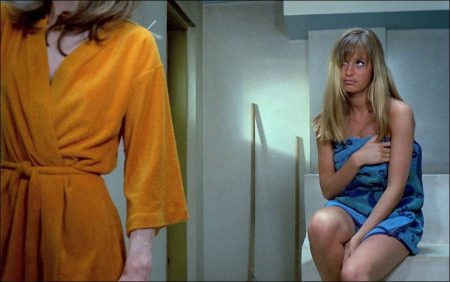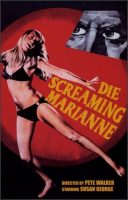Taglines: Death bars the gate to her 21st birthday.
Die Screaming, Marianne movie storyline. After their parents divorce, one daughter lives with her mother in England while the other lives with her father in Portugal. After the untimely death of her mother, the one daughter stands to inherit a large sum of money and also a number of documents containing information that will incriminate her father, who was a crooked judge. While her father wants the documents, her sister wants the money and they will each stop at nothing, even murder, to get what they want.
The first horror film from notorious British director Pete Walker, this is a brutal but rather pedestrian pulp thriller about a fetching young go-go dancer (Susan George, in her first starring role) who is stalked in and around an isolated house by ruthless assassins determined to prevent her from reaching her 21st birthday. It seems Marianne is in line for a sizable inheritance from the man she claims is her father — a crooked magistrate whose career is threatened by her very existence.
As if that weren’t enough, knowledge of the girl’s newfound wealth inspires a team of would-be kidnappers who show up at the villa to beef up the body count. Fans of Walker’s blood-drenched thrillers might detect a glimmer of burgeoning talent here, but the suspense is hampered by a clunky script and silly dialogue, and the lovely George is probably just warming up for the following year’s Straw Dogs. Also known as Die Beautiful, Marianne!
Die Screaming, Marianne (also Die, Beautiful Marianne) is a 1971 British low-budget film by minor cult director Pete Walker. Although Walker’s films were mostly in the horror or sexploitation genres, this is a straight thriller, with mild horror undertones. The film stars are Susan George, Barry Evans, Chris Sandford, Judy Huxtable, Leo Genn, Kenneth Hendel, Paul Stassino, Alan Curtis, Anthony Sharp, Jon Laurimore and Martin Wyldeck.
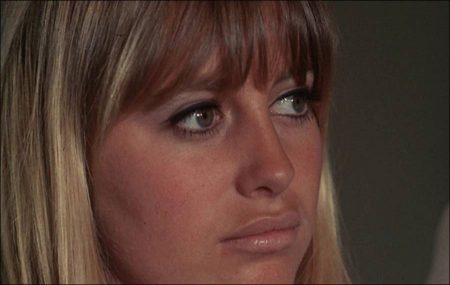
Film Review for Die Screaming, Marianne
There’s no stopping Odeon Entertainment this month. Not content to spoil us with a clutch of British horror films in March, they now dig out several more exploitation classics from the archive and re-release them onto an unsuspecting world.
For Pete Walker aficionados out there there’s a double treat with the legendary horror film Frightmare and one of his early 70s noir thrillers Die Screaming Marianne both getting a release. The Pete Walker films were last released as part of an Anchor Bay UK box set in 2005 and came with a host of special features, including commentaries from Walker and Walker experts Steve Chibnall and Jonathan Rigby.
After working in the British industry for some time, Walker eventually ended up making cheap sex comedies at the end of the 1960s and if you’re looking for someone to blame for foisting upon us the career of Robin Asquith…then look no further than his surprisingly competent film Cool It Carol (also available from Odeon). By 1970, he’d turned to making noirish Hitchockian thrillers with the rather splendid Man Of Violence (available in the BFI’s Flipside DVD range) followed by Die Screaming Marianne.
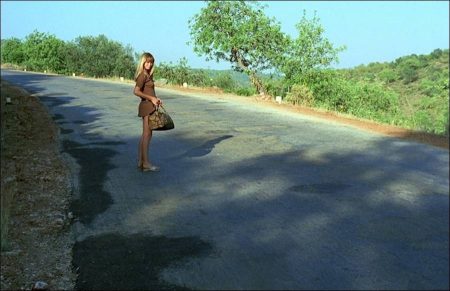
Walker’s thrillers echoed some of the similar attempts by Hammer to produce psychological dramas during the 1960s, such as Crescendo, Taste Of Fear and Paranoiac. He also invests both films with a critique of the modern family – particularly father figures – and political and judicial corruption, the depressing slide of aspirant 1960s hopes into the economic melt down of the 1970s and in Man Of Violence even offers a film with a bisexual hero. The nature of evil, the causes of violence and crime are very much Walker’s concerns and in both the early thrillers and horror films he sees people and institutions as the root of these problems.
Die Screaming Marianne rather defies the implications of its own title. Marianne does neither. However, it’s not a conventionally happy ending for her – something of a Walker hallmark. Marianne, played very well by the luminous Susan George, here in her second film, is a young go-go dancer on the run from her seedy ex-judge father (referred to as the Judge strangely enough), a loopy half-sister with a kink for incest, Hildegarde (an eye-rollingly mad performance from Judy Huxtable, the second Mrs. Peter Cook) and a hired kidnapper Sebastian (the louche Christopher Sandford). Basically, they want to get their hands on incriminating letters and a fortune stashed away by her dead mother Ruth and they’ll do whatever they can to get the number of the account from her.
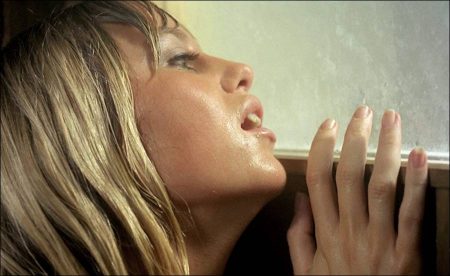
Sebastian picks her up on her escape from The Judge’s rather smart villa in Portugal and attempts to marry her in order to get access to the money. Marianne’s a bit more canny than that and upsets Sebastian’s plans by marrying his friend Eli (the young and very cute Barry Evans who would go on to a major career in television sit-coms such as Doctor In The House and Mind Your Language). Bolstered by an outrageously camp, almost Bondian title sequence, depicting George in a black bikini draped with chain mail go-go dancing in front of a blood red back drop to Cyril Ornadel’s brassy and infectious title music, the first half of the film is solid, if conventional, fare.
There are two rather good sequences in the first half. After getting a lift with Sebastian in Portugal, Walker places George and Sandford’s dialogue over a sun-drenched drive down a hillside, inter-cutting between close ups, landscapes and the car. Brief but effective. Later, after The Judge has tracked Marianne and Eli down in London, two of his henchmen pick Eli up and take him to a seedy brothel.
They hold him there with no explanation and Walker really shows his talent here as he edits between a nervous Barry Evans, playing Eli’s fear with utter conviction, and the sinister John Laurimore who doesn’t speak a word but indicates his intentions in front of him by fitting a silencer to a gun and then twisting a broken washing line between his hands.
The framing is superb and Eli’s fears are then further justified as Walker cuts to him looking out of the window to see the other man preparing the boot of his car and unloading a blanket to wrap up what will be Eli’s body. Eli only escapes by locking one man in the bathroom and stabbing the other with a pen-knife on the stairs. A brilliant sequence.
After a rather extended search by Eli and Sebastian for the runaway Marianne, the story re-locates back to Portugal and the film starts to flag. Whilst Walker generates a hothouse atmosphere of mounting tension, lacing it with a frisson of incest and violence (a disturbing scene between Hildegarde and the Judge using reflections in mirrors to visually distort the meanings), he does stretch this to such a degree that it gets a little bit tiresome and the film really needs to reach a conclusion much earlier than the one he arrives at here. That said, he uses the Portugal locations very effectively, with George the centre of attention in scenes showing her, tanned and bikini clad, emerging from the sea and sunbathing, whilst isolating the characters in a sort of poisonous paradise in the Judge’s villa.
Here Hildegarde and Sebastian torture Marianne by locking her in a steam bath and her father ends up plunging off a cliff top in a rather delirious car crash sequence intended for Eli. The hero of the film, Eli, whom you suspect might turn out to be Marianne’s saviour, does meet a violent end and it’s a genuinely effective twist when she is taken by the police to identify his body.
Walker stages the climax of the film in a ruined abbey, shooting day for night, but even here doesn’t seem able to generate much suspense apart from Hildegarde’s sadistic use of a lighter to torture Marianne. Sebastian is left to die, along with his parade of excruciating fashion disasters worn in the film, in what looks like the bottom of a grave and the Pallenberg-like Hildegarde is choked to death by The Judge’s faithful retainer Rodriguez. Marianne is left shedding bitter tears in a very downbeat ending.
Susan George and Barry Evans are appealing as the two lead characters and have a genuine chemistry, providing the best performances in the film. Huxtable is suitably nasty and Sandford just about acquits himself. Leo Genn, a mainstay of Walker’s films, mumbles through much his role as The Judge and lets the side down a bit. Cyril Ornadel provides a brassy, driving soundtrack to a half decent film that meanders wildly off the beaten Algarve track about half way through where it could have done with some judicious editing and clarity.
The DVD uses a fairly decent print but there is quite a bit of damage and dirt here and there. It’s in an anamorphic widescreen 1.85:1 format, quite grainy with a colour palette that reflects both the greyness of the London set sequences and the brighter more vivid blue skies and rugged coastline of the Algarve. We also get the Walker and Jonathan Rigby commentary ported from the Anchor Bay set, a ten minute interview with the affably modest Walker, a gallery of stills, posters and lobby cards and a batch of trailers for Walker films including Frightmare, Cool It Carol, The Flesh And Blood Show and Home Before Midnight. Not a bad offering from Odeon.
From the slightly ridiculous to the sublime with Walker’s Frightmare, arguably one of his most coherent films and worthy of joining the ranks of contemporary British horror, in the company of such films as Death Line, that anticipated the realist approach to the genre emerging from the US.
At the heart of the film is an attack on the conventions and structures of family life and on the failure of institutions and psychiatric medicine to cure the criminally insane. But it’s done with such gleeful and mordant black humour and a truly exploitative use of cannabalism, a trend in horror films that blossomed during the 1970s, that the subtext takes second place to a glorious performance from lead actor Sheila Keith. Keith, a member of the Walker repertory company, as Dorothy Yates is joined by Rupert Davies as Edmund Yates.
Both were committed to an institution for the insane in 1957 for Dorothy’s unspeakable murders and cannabalism and he for attempting to cover her tracks. Some 15 years later, they have been released, considered fit to rejoin society. But are they? Their eldest daughter Jackie has her doubts and begins to fear that Dorothy still has her blood lust. Debbie, their youngest daughter, showing some sadistic tendencies in her own delinquency, has started to unearth the background to the strange family into which she has been born.
It’s quite a disturbing and unsettling film, suggesting that not everything is as cosy as it seems under the outwardly normal lives of British families. And it doesn’t pull its punches when it comes to showing how the psychiatric ‘talking cure’ is pretty useless in the face of deep neuroses (oh, and hereditary cannablism). Whilst Dorothy and Edmund live in isolation in a lonely farmhouse, Jackie has started to date Graham (Paul Greenwood, of sit-com Rosie) a psychiatrist who thinks he can solve Debbie’s rabid delinquency by unpacking the motivations behind her maladjustment.
It’s clear from Walker’s observations on the commentary that the cannabalism angle of the story was simply put there by him and scripter David McGillivray to up the gore and violence and give the film its unique selling point. Nothing wrong with that, especially when the victims are on the receiving end of Sheila Keith’s wonderfully unhinged performance as Dorothy.
We follow the dysfunctional family fortunes as Jackie grows more and more concerned about Dorothy and Debbie. What’s striking is the loving relationship between Dorothy and Edmund where she elicits our sympathy as a tortured and confused pensioner and you empathise with his struggle to cover up her atrocities. Keith turns her performance on a sixpence, one minute a lonely old soul seeking refuge from the harsh realities of the world and the next a drill-wielding maniac with blood spurting all over her face. She’s quite fabulous in this film and you can understand why Walker enjoyed working with her.
There’s also a strange dream sequence where Jackie meets a pallid, red eyed Dorothy on a train which is superbly evocative and provides the audience with a sense of foreboding about her eventual fate. The film hurtles towards a very downbeat climax. Graham uncovers the history of Jackie’s parents (Walker regular Leo Genn has a little cameo as a Doctor who helps him) and Dorothy’s ‘pathological cannabalism’ (as it is described by Gerald Flood as one of the consultants at the Lansdown institution). Jackie is not convinced that the nightmare of her parents crimes is over despite Graham’s admonitions to the contrary.
Meanwhile, Debbie finds the farmhouse and is reunited with her parents whilst her biker boyfriend uncovers the bodies in the barn. Alas, he also comes to a sticky end in a gloriously over the top welter of gory violence dealt out by a fiercely grinning Sheila Keith. Poor old Edmund is driven to the end of his tether when Debbie proposes that the next victim be Jackie and he also has to deal with Graham turning up at the farm in the hope of talking some sense to Dorothy. Mad old Dorothy soon sees through him and it’s an extremely grim scene that greets Jackie when she finally arrives and her father admits of Dorothy that ‘she’s had a very serious relapse I’m afraid’. The understatement of the year, Edmund. It’s bleak, bloody and thoroughly depressing as the dysfunctional Yates family turn on her.
An under-rated British horror film, steadfastly modernist in the face of the Hammer and Amicus product of the time and looking towards the contemporary horror of American cinema for its inspiration. Keith and Rupert Davies (as Edmund) are superb, Deborah Fairfax as ‘final girl’ Jackie is pretty good too. I did find Kim Butcher a little shrill as Debbie but that may well have been the intention in order to make her as obnoxious as possible. Look out for Andrew Sachs in the opening scenes and Crossroads Victor Winding as the DI working on the murder committed by Debbie. The film is supported by a effective score from Stanley Myers.
Die Screaming, Marianne (1971)
Directed by: Pete Walker
Starring: Susan George, Barry Evans, Chris Sandford, Judy Huxtable, Leo Genn, Kenneth Hendel, Paul Stassino, Alan Curtis, Anthony Sharp, Jon Laurimore, Martin Wyldeck
Screenplay by: Murray Smith
Production Design by: Robert Fennell, Doreen Merriman
Cinematography by: Norman G. Langley
Film Editing by: Tristam Cones
Makeup Department: Charles E. Parker
Music by: Cyril Ornadel
MPAA Rating: None.
Distributed by: Anchor Bay Entertainment
Release Date: August 13, 1971
Views: 250
